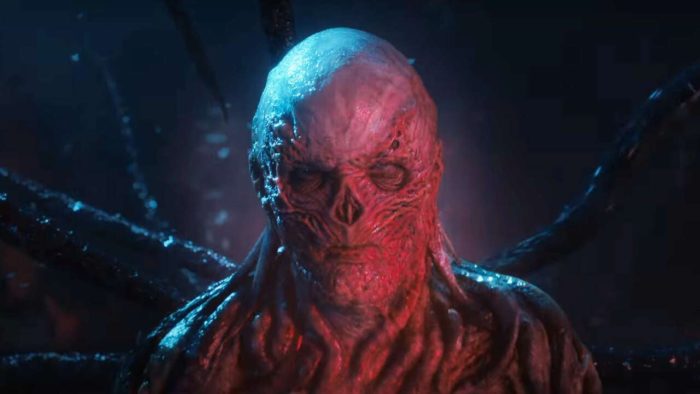When we last left the quiet little town of Hawkins, Indiana at the end of Stranger Things 3, just about everything we had taken for granted since the show began had been thrown into question. Hopper was presumably dead, Eleven’s psychic powers were gone, the gate between the Upside Down and the real world was closed, and the Byers family was moving out of Hawkins to live out in California. Now, almost three years later, Stranger Things is finally back, bigger, darker, and stranger than ever before.
Talking about Stranger Things 4 is, as of now, a somewhat unusual task. The new season is being released in a split format—the first seven episodes are what we have so far, with the last two coming out on July 1st. So it feels a little, well, strange to talk about what’s happened this season knowing that we won’t know how it ends for another five weeks or so. Perhaps even stranger than that is how complete this first batch of episodes feels. It’s certainly a cliffhanger ending, but it’s one that could just as easily have led into another season, not simply a “wait five weeks and find out how it all wraps up on the next exciting episode of Dragonball Z.” Not that I’m complaining by any means, just noting that it’s an approach that feels unusual, especially given that one of the early appeals of Netflix (and streaming services in general) was being able to get a whole season at a time and watch at your own pace.
In the nearly three-year buildup to the release of Stranger Things 4, much was made of the new season looking to have an increased focus on horror, along with a more mature tone to account for the younger members of the cast now reaching full-blown adolescence. Additionally, in a trailer breakdown with IGN, the Duffer Brothers even revealed that since Season 2, they had wanted to do a character in the vein of Freddy Kruger, Pinhead, or Pennywise.
Given that that’s a somewhat high bar to set for themselves, the main question that Stranger Things 4 had to answer for me was: can they deliver on the horror front? In a word, absolutely. The time we spend in Hawkins (the show does branch out into storylines in California and Russia, but the horror is mostly confined to the Hawkins front so that’s where the majority of our focus is going to be) is marked by not only a new intensity in its scares but also by a tangible shift in what kind of horror faces our cast. Gone are the days of Season 1’s Alienesque monster horror or Seasons 2 and 3’s Lovecraftian touches; now, the scares are of the more psychological, more unsettling type, with several sequences being full-on nightmares come to life.

Vecna—as the season’s new big bad is known by the Hawkins gang—is a nightmare of an entirely different nature than anything the show has thrown at us so far. A so-called “dark wizard” who remotely invades the minds and memories of his chosen victims, Vecna dredges up their worst fears and worst memories to torment them with before disposing of them. As with all things Stranger Things, he’s a glorious hodgepodge of “things we loved from ’80s sci-fi/horror,” and while Freddy Krueger and Pinhead are certainly the most obvious influences on him, one can also see visual influences from the likes of Red Skull while the tentacles he seemingly has to integrate with in order to carry out his remote attacks almost feels like a fleshy, organic version of Professor X’s Cerebro.
The common thread uniting all of Vecna’s victims is extreme anxiety and guilt, which proves to be rich material for some of the show’s most disturbing imagery. Chrissy, the Laura Palmeresque “seemingly perfect All-American Girl whose life is much darker than you think and whose murder kicks off a series of events that permanently change life in a small town” character, is forced to relive the trauma of her home life that lead to her eating disorder and drug abuse. Fred, an aspiring journalist working with Nancy to investigate Chrissy’s murder, is tormented with the memory of a fatal car accident from his past, including one memorable scene with a group of ghoulish mourners accusing him of being a murderer. And most harrowing of all, Max finds herself squarely in Vecna’s crosshairs as he preys on her guilt over Billy’s death in Season 3, culminating in a climactic, fantastical sequence set to Kate Bush’s “Running Up That Hill” that feels straight out of Nightmare on Elm Street 3.
Disappointingly, there is one aspect of Vecna that falls short: his kills. In theory, they’re a disturbing sight to behold: a human body being levitated midair as an invisible force snaps their bones and gouges their eyes out. The problem is that they’re some of the season’s more obvious CGI, and the end result looks more cartoonish than gruesome. But even with that in mind, I won’t sugarcoat it: Vecna is quite possibly my favorite part of the new season and hands down my favorite villain in all of Stranger Things. He is a sinister combination of the otherworldly and the all-too-human that’s more compelling than anything that could have been done with the likes of the Demogorgon or the Mind Flayer. It even feels like the show is being slightly retconned to have him be the one who’s been behind the scenes of all the events in Hawkins so far, a direction I’m sincerely hoping they take the show in.

Meanwhile, the Hawkins gang is in search of answers following the latest stretch of killings, a journey that takes them on what is basically a full tour of classic horror scenarios: a visit to see Victor Creel (played by the always excellent Robert Englund) at an insane asylum, a tense search through a haunted mansion, and an after-dark encounter at the lake that feels like Jason might pop out at any minute. Nothing here is particularly innovative—innovation was never the name of the game with Stranger Things anyways—but it demonstrates the creative team’s knowledge of ’80s horror, and each of these moments is executed in a way that feels evocative of classic horror without feeling overly derivative.
But as if that wasn’t enough, Hawkins also finds itself a hotspot for horrors of the real world variety. The mall fire from the end of Stranger Things 3 is still firmly rooted in the town’s psyche, and when the new batch of murders starts up it sends the residents of Hawkins into a full-blown Satanic Panic, believing that new character Eddie’s Dungeons and Dragons group is a front for Satanic rituals and responsible for said murders. It’s the least visual thread of the show’s new focus on horror, but it’s some of the more unsettlingly “real” scares as we watch disinformation and rumors spread amongst the townsfolk and eventually spiral further and further out of control until they wind up forming a full-on mob to hunt Eddie down.
The other side of the show’s dive into the more cerebral variety of horror: El’s story which takes place in Nevada. Early on in the series, El is taken back into the custody of the US government and reunited with both Dr. Brenner and Dr. Owens, who hope to help her regain her powers through the use of a machine called Project Nina. The details of how the project works are still somewhat unclear, but the important thing to know is that it allows El to relive and interact with her repressed memories of her time in the Hawkins lab. Almost all of El’s story so far this season has been flashbacks, making frequent use of unsettling dream logic and imagery as she’s forced to play along with her memories, getting closer and closer to the heart of her traumatic past.

As it turns out, Eleven’s past is closely tied to the most recent batch of happenings in Hawkins. As we come to find out, Vecna is none other than Henry Creel—later known as “One” or subject 001, the first of the children with psychic abilities that Dr. Brenner experimented with. He later wound up working at the facility as an orderly, and not only is he the one responsible for the massacre that took place at the lab, but Eleven’s opening of the gate was to send him into the Upside Down after she refused to join him and he attacked her. In short, Vecna is basically the X-24 to Eleven’s Wolverine—the evil, more powerful version of her that the show was always missing, and the inevitable showdown between the two is one that could very well be the event of the summer.
That showdown will likely come in those final two episodes. Given that Episode 8 clocks in at just under an hour and thirty minutes, while the final episode is just under two and a half hours, we still have quite a ways to go. A short teaser for the last two episodes was released alongside Volume One, and from what we can see, it certainly looks like everyone is gearing up for a war—no matter what part of the world they’re in.
Meanwhile, the titles for the two remaining episodes take on new meaning given what we know. “Papa”—which I had originally thought would be an El backstory episode—will probably dive deeper into Vecna’s time with Dr. Brenner and could very well include a confrontation between the two, while “The Piggyback” could possibly see Vecna somehow enter our world, likely by possessing one of our cast. The season is set to wrap up with the release of Volume 2 on July 1st, with an ending that the creators say will springboard directly into the fifth and final season. I’ll wait until then to deliver a final verdict, but so far Stranger Things 4 has been a tremendous season for the show, and a deeper dive into the stuff of nightmares than anything the series has taken before.



